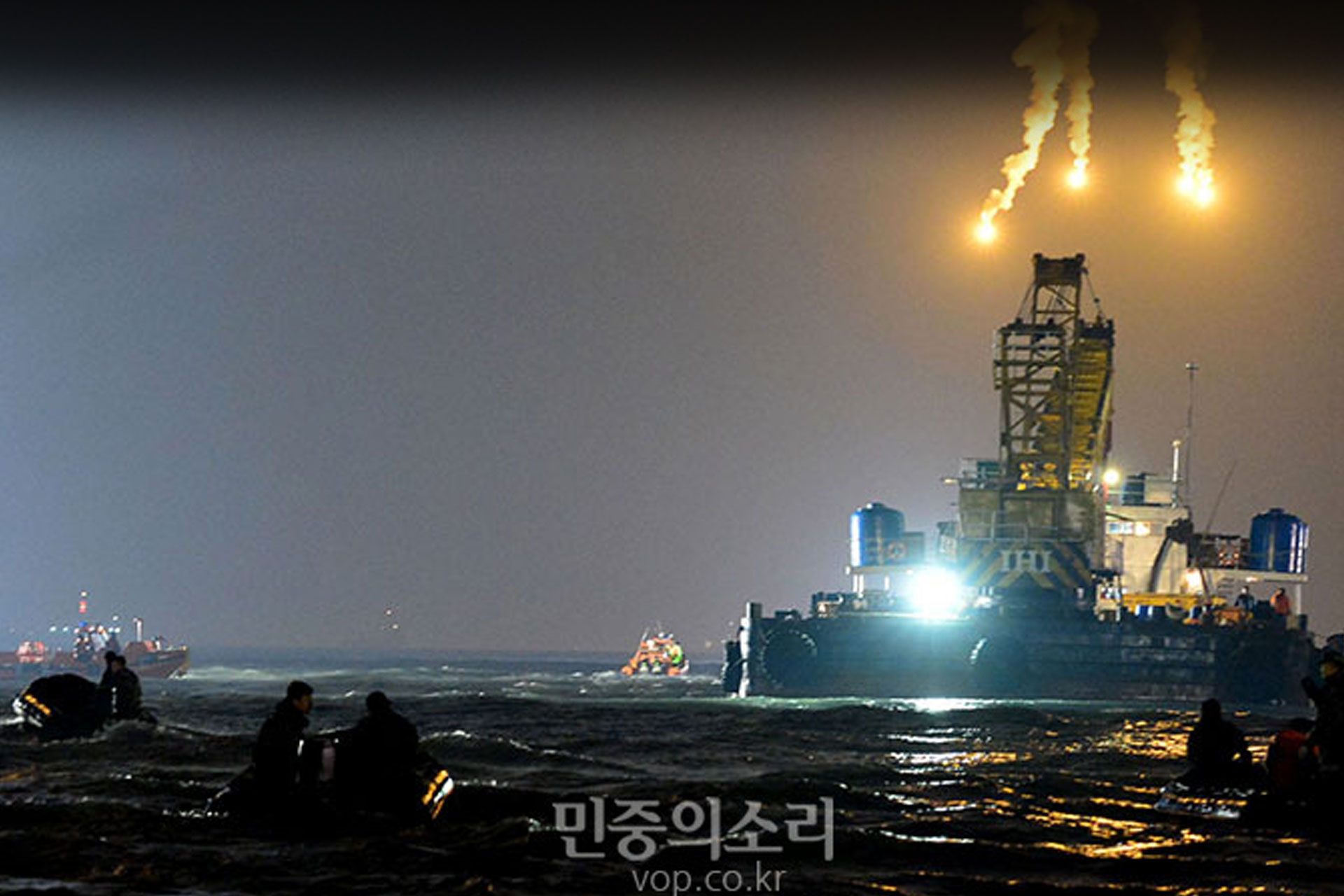

The Adults
Should Not Be Forgiven
[Ferry Announcement] "Stay where you are. Do not move. Wait."
Despite the boat suddenly tilting, nobody imagined they would die. “Everything will be fine if we follow the adults' instructions. Just listen to the attendants, put on the life jackets, stay where we are, and the coast guards will save us.”
“The boat continues to tilt so it’s quite troubling, but we are together, we have our friends with us.”
“We hold each other's hands and tie our life jackets together.”
“Some take off their life jackets for those without one, reassuring them that they can find another one.”
Two oil tankers nearby were the first to reach the sinking ferry. The oil tankers were too large to get close but stood by to save those who jumped into the sea.
But oddly enough, even though the ferry was so tilted that fastened cargo was falling off from its sides, there was no sight of passengers fleeing to the deck.
The coast guard helicopters arrived soon after. The students in their cabins thought they were being rescued, and the crew repeated the announcement to stay put. But the boat continued to tilt. Waves started hitting their cabin windows. The ship was surely sinking. They thought of their mothers and fathers. They thought of their brothers and sisters.
As the sea water rushed into their cabins they realized they could really die if they stayed there, but it was too late. The cabin floor had already slanted over 60 degrees; reaching the deck would be almost impossible, as getting out of the cabin itself had become an obstacle. The narrow corridor was already a tangle of people frantically trying to get out. The sound of helicopters buzzed above but help did not arrive.
Around 9:30 am, the coast guard boats arrived and helped some people out. The captain and crew, who had escaped to the steering house early on, were now abandoning ship, leaving the passengers behind.
The next to be rescued were the passengers who instinctively escaped, disregarding instructions to stay put. They hung on the railings, waited, and were rescued by helicopters. There were other passengers who jumped into the sea. They were rescued by Jindo fisherman who brought their fishing boats, replying to the distress signal.
The Sewol ferry leaned further and further to its left, and then overturned completely, leaving only a smidgen of its underside above the water. 290 passengers, including the 2nd year students of Danwon High School on a school trip to Jeju-do, were now trapped in the dark and cold sea.
The captain and crew who abandoned ship while leaving the young passengers behind, the incompetent coast guard compared to the fishermen of Jindo; the incomprehensible actions of the captain and crew, the inadequate early efforts of the coast guard resulted in the students going down the road of no return.
In the end, not a single soul was saved. What did the government do? What did the country do? It is not only the grieving families who are asking these questions.
The ferry’s underside peeking above the water seemed like a hopeful sign that the students were still alive inside. Frustrations were running high at the government's slow search. During the first two days, when every minute and second counted, the government announced that approximately 500 divers, 20 helicopters, and 100 ships were carrying out the rescue mission.
It would be an understatement to say that this was misleading. Although the coast guard was unable to properly search underwater the first day, they had excluded veteran civilian divers from the search and ordered the company operating the Sewol ferry to take charge of a salvage operation. On the second day, the ferry company signed a contract giving sole rescue rights to the private company Undine, which had been recommended by the coast guard. The coast guard also went on to restrict the Navy from joining in the rescue.
Instead of putting in all their efforts to save people by utilizing all the civilian and Navy resources possible, they put priority on the salvage of the boat, citing the possibility of damage to the fisheries nearby.
There are over thirty rescue companies in Korea with six around Mokpo, the largest port in the area. But even though the coast guard has the right to call them to duty in emergencies, not a single one of them was summoned. It was an ominous start.
The complex and cozy relationship between the coast guard, maritime associations and organizations, and private companies is suspect. There was no nation that was trying desperately to save lives, and the coast guard seemed to be supporting the monopoly of a private company. Human lives were at stake and people were calculating monetary profit.
The nation's frustration and despair mounted as irregularities continued to surface. Chonghaejin Marine Co., which operated the ferry, was exposed to have been oblivious to the safety of the passengers, even as the ship was sinking. The ferry had fixed its records and was carrying an estimated 3,608 tons of cargo, more than three times what was deemed safe by authorities. It also had shed much of the ballast water necessary to maintain stability to accommodate the extra freight. While the ferry company had spent about $60,000 per year on entertainment expenses, only $500 was spent on safety training. The company had acquired a 1994 Japanese ship nearing the end of its life, and was only able to run the recklessly modified ferry due to weakened government regulations.
The Sewol ferry was a ticking bomb, ready to go off at any moment.